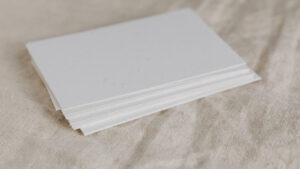Last Updated on November 3, 2025 by Packoi Team
Packaging plays a huge role in establishing a brand’s identity. Tiffany & Co.’s packaging is renowned worldwide for its elegance and premium appearance, making it instantly recognizable.
In this Tiffany’s packaging guide, we’ll learn the history and significance of Tiffany packaging, along with design tips to help you create luxury packaging for your brand.
The Secret Behind Tiffany’s Blue Box
Luxurious packaging is more than a box. It is a status symbol designed to make customers feel valued and special. Let’s see what makes Tiffany’s Blue Box so special.
1. The Signature Color

Tiffany boxes use a special variant of Robin’s Egg Blue. It’s a beautiful light blue color with hints of green; it resembles turquoise gemstones. The blue shade was later refined by Pantone into our modern understanding of “Tiffany Blue” for a uniform design across all products.
The company trademarked the color in 1998, getting exclusive rights to use that specific shade in the jewelry industry. Since then, Tiffany & Co. has made sure that Tiffany Blue is synonymous with luxury packaging.
2. The White Satin Ribbon
Tiffany’s next major identifier is the soft, satin white ribbon. The ribbon is a key part of Tiffany’s packaging, transforming the product box into a gift. It sends a message to their customers that Tiffany’s products are gifts for their loved ones and for themselves.
The white color cuts through the blue background and ties the whole packaging design together. In recent years, Tiffany & Co. has also been using that white satin accent to style its gift bags.
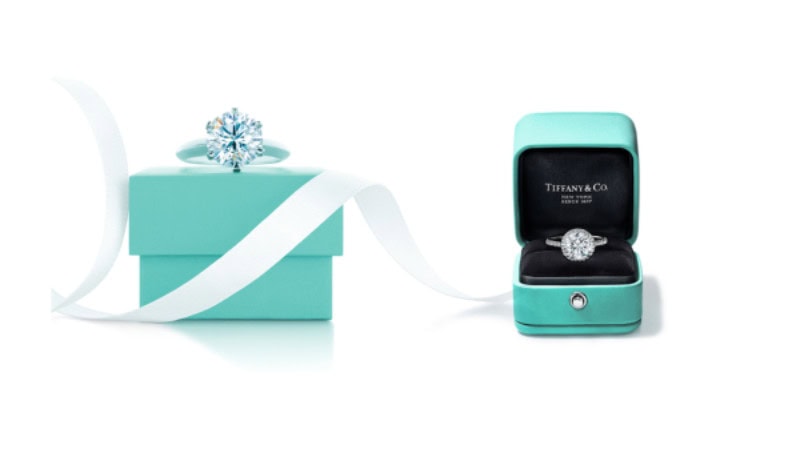
Unwrapping that white ribbon adds another step towards the jewelry. Customers have to work and put in effort to get to their new Tiffany jewelry. This unboxing step conveys a sense of earning the reward inside.
3. Premium & High-Quality Materials
Tiffany’s commitment to go above and beyond in delivering quality in every aspect, including its packaging. The packaging boxes and materials are just as exceptional as the jewelry inside. Tiffany packaging reflects expert craftsmanship and a commitment to quality.
Each Tiffany package is not only beautiful but also durable and sturdy. The iconic Tiffany box is made from high-quality paperboard, a thick yet lightweight material made from fibers. To complement the box’s elegance, there is a white satin ribbon, adding a premium touch to the unboxing experience.
A standard Tiffany product has three layers of packaging design. A hard plastic jewelry box, an outer rigid cardboard packaging, and finally, the blue paper gift bag. Whether you’re buying earrings, bracelets, necklaces, or a wedding ring, the Tiffany packaging remains consistent.
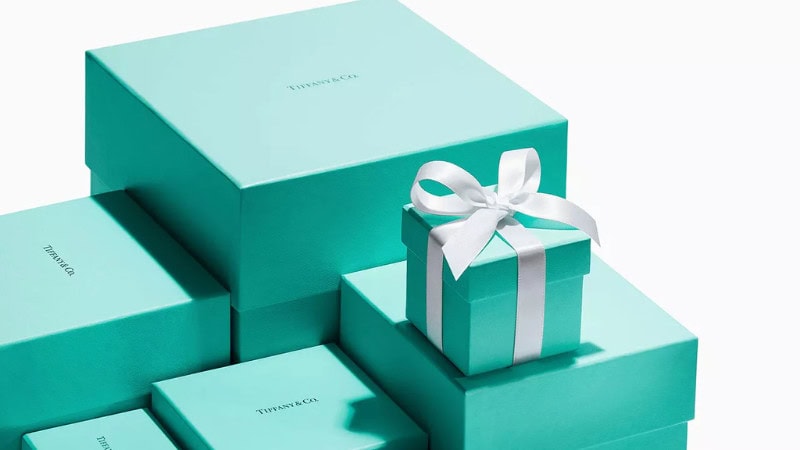
4. Minimalist Branding & Details
Tiffany has established a clean, minimalist branding campaign that is focused on that gorgeous blue color. Tiffany doesn’t need to put their name on their blue boxes. The authenticity comes from its color, sophistication, and charm. You know it’s a Tiffany’s box when you see it.
- Carrying Bags: You will only see the Tiffany name on the external paper bags. It’s simple black text in the Tiffany font, and in a fairly small size.
- Product Box: Previously, the outer blue box had an embossed logo on the top. But today it only comes with that white ribbon.
- Jewelry Box: The inner jewelry box also has only one small chrome button on the front.
- Box Interior: The inside of the jewelry box is covered in a velvety black fabric. It cushions your choice of jewelry, letting it stand out from the black background. Finally, the inner top of the gift box has the Tiffany & Co. name printed in white.
Tiffany’s minimalist branding showcases exquisite craftsmanship. It looks simple, but it’s a result of hundreds of well-thought-out decisions.
The Story Behind the Color: How Tiffany Blue Became a Brand
Tiffany & Co. was founded by Charles Lewis Tiffany in 1837 in New York City. The nearly two-hundred-year-old company is an American icon. Let’s take a trip down memory lane and explore Tiffany’s rich history.
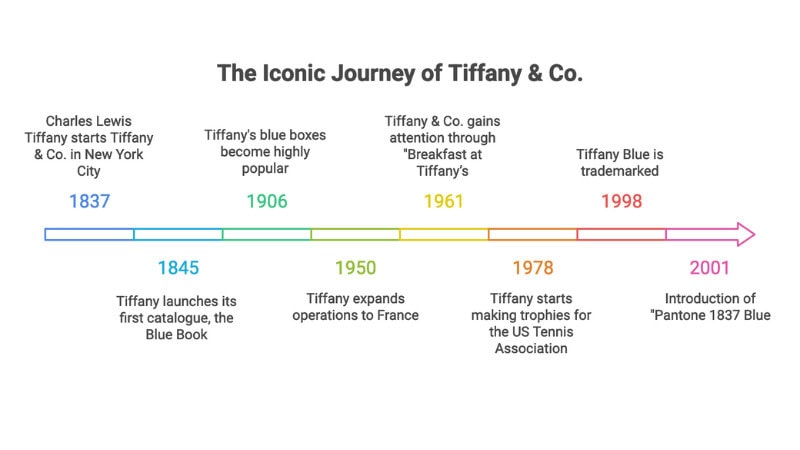
- 1837 – Charles Lewis Tiffany starts Tiffany & Co. in New York City with its signature packaging, the humble blue box.
- 1845 – Tiffany launches its first catalogue, the Blue Book, a collection of handcrafted jewelry designs with gemstones and silver accents.
- 1906 – The New York Sun reports that Tiffany’s blue boxes had become so popular that even if you could pay as much money as you wanted, Charles Lewis Tiffany wouldn’t sell you the box.
- 1950 – Tiffany expands its operations and opens its first branch in France. Later, Tiffany would open a store in London (1968).
- 1961 – Tiffany & Co. gains the world’s attention through the American classic film, “Breakfast at Tiffany’s”.
- 1978 – Tiffany expands their work and starts making trophies for the US Tennis Association.
- 1998– This blue shade was officially trademarked as Tiffany Blue, securing its exclusivity to the brand.
- 2001 – In collaboration with Pantone, the company introduced the “Pantone 1837 Blue” color.
Over time, the Tiffany Blue Box has become more than just packaging. It represents cherished moments in people’s lives, such as birthdays, weddings, anniversaries, and engagements. Adorned with a beautiful white satin ribbon, it evokes excitement and anticipation, establishing it as a symbol of prestige and exclusivity.
How Packaging Became Tiffany’s Chief Marketing Officer
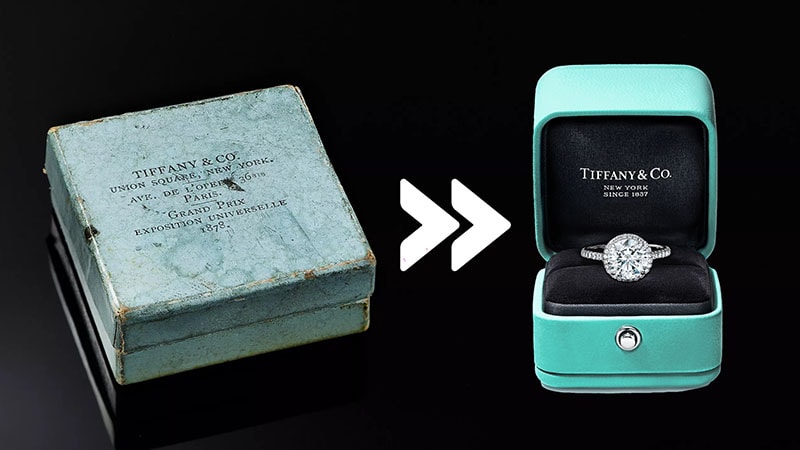
Whether it’s the annual product catalog called the Blue Book or customer unboxing videos on social media. Tiffany’s blue packaging design is its main marketing tool.
Unboxing as an Emotional Experience
Tiffany’s packaging turns unboxing into an experience of its own. The act of untying the soft white satin ribbon, lifting the perfectly crafted lid, and feeling the smooth texture of the box creates a memorable sensory experience for the customer.
These legendary boxes are not openly available; they come exclusively with a Tiffany purchase. This rarity makes them even more special. Owning a Tiffany product feels like being a part of the legacy of elegance and timeless luxury.
The Cultural Status Symbol
Tiffany has quickly become a status symbol in our modern society. Today, affluent women from around the world aspire to shop at Tiffany’s.
We can trace this cultural status shift to the 1961 classic film, “Breakfast at Tiffany’s“, starring Audrey Hepburn as the lead, Holly Golightly. Outside of being a wonderful romance comedy, it was the first movie to show Tiffany’s flagship store on Fifth Avenue in New York City.
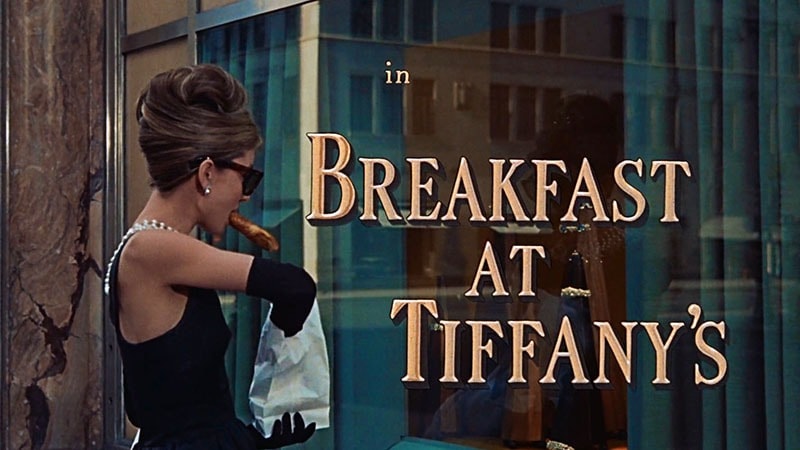
The movie ties elite status to the idea of being in a Tiffany’s store. It implies that Audrey Hepburn’s timeless beauty is tied to shopping at Tiffany’s. After its box office success, the Tiffany company embraced the movie further, solidifying Tiffany’s place in modern high society.
Commitment to Sustainability
At Tiffany and Co., luxury and sustainability go hand in hand. For over 25 years, the brand has been a pioneer in sustainable luxury, continuously adopting environmentally friendly practices.
In 2022, over 98% of the precious metals used in Tiffany’s jewelry, accessories, and watches came from traceable, recycled, and non-mined sources. Moreover, more than 65% of the materials in Tiffany’s blue boxes and bags were recycled.
The brand aims to achieve net-zero greenhouse gas emissions across all operations and the supply chain by 2040. In 2004, they discontinued the sale of coral jewelry to protect marine ecosystems.
Tiffany & Co. has also pledged to donate at least $1 million to The Nature Conservancy project to support the conservation of approximately four billion hectares of ocean by 2030.
5 Steps to Apply Tiffany’s Iconic Principles to Your Brand
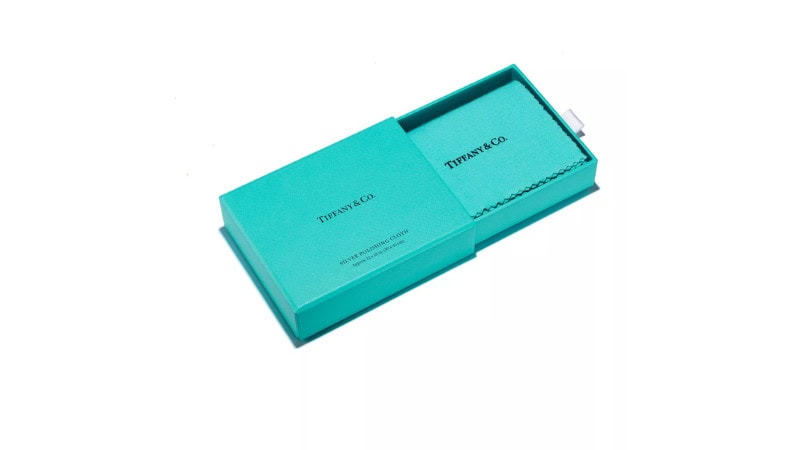
Tiffany & Co. has set the gold standard by making its packaging as desirable as the product. Businesses can learn from Tiffany’s approach to develop visually striking, aesthetic, and instantly recognizable packaging.
Below is a step-by-step guide on how to design packaging like Tiffany’s:
Step 1: Define Your Brand Identity & Signature Color
Tiffany’s brand identity is built around luxury, exclusivity, timeless elegance, and trust. Similarly, defining your brand identity requires a strategic approach.
- Understand Your Brand Values: Identify your target audience and consider their preferences and expectations. Develop a distinct brand personality that aligns with your vision and resonates with the audience.
- Choosing a Signature Color: Research shows that color can improve brand recognition by up to 80%, making it a powerful marketing tool. When selecting your brand’s color, consider its psychological impact. Red conveys passion and energy, blue suggests trust and reliability, while yellow shows optimism and enthusiasm.
For example, in the tech industry, the color blue symbolizes innovation, trustworthiness, and security.
Step 2: Prioritize High Quality Materials
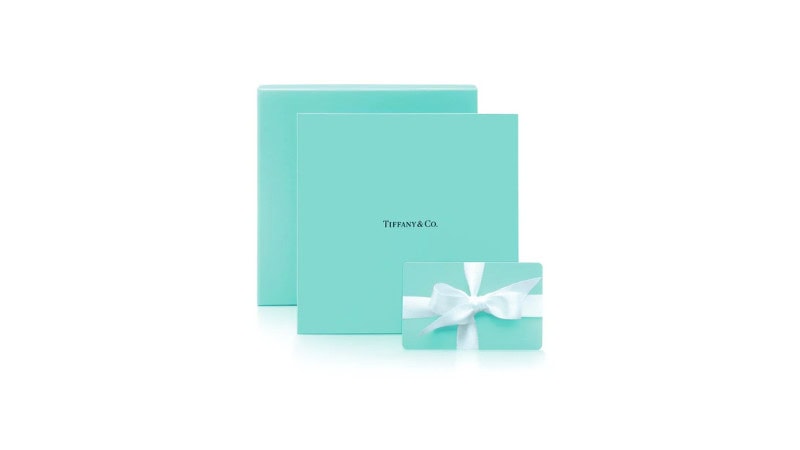
According to a survey, 67% of American consumers say that the materials used in a product’s packaging influence their purchase decisions. Consumers associate durable, well-crafted packaging with a brand’s commitment to excellence.
Conduct some market research and see what materials your competitors are using. Explore similar materials while considering their texture, weight, and sustainability.
Investing in high-grade materials such as rigid boxes adds to the premium feel. Adding inserts can further protect your products and improve the unboxing experience.
Step 3: Add a “Luxury” Finishing Touch
Luxury packaging design is all about the little details. For Tiffany & Co., the small satin ribbon gives a gift-like feel, building anticipation and excitement, while the embossed logo makes the product feel exclusive.
You don’t need extravagant options to achieve a premium look. Thoughtful finishing touches, such as ribbons, glossy coatings, embossed designs, or foil-stamped logos, can create a premium, memorable experience for customers.
Step 4: Design the Full Unboxing Experience
Think beyond the packaging itself. Traditional packaging design focuses on product safety and branding. However, luxury packaging heavily favours the unboxing experience itself. Let’s take some unboxing tips from Tiffany’s packaging.
- Use a custom-designed paper gift bag. Higher quality paper with a soft touch matte finish feels good on your skin. Removing the product from the bag is not a chore but another satisfying experience.
- Use thicker cardboard boxes. It brings heft to your packaging design, which is often associated with quality. Size and weight imply quality packaging, which implies quality products.
- Use sound to your advantage. Tiffany blue boxes have a satisfying click when you open and close the box. It stands out from other generic packaging that feels like an afterthought.
In the modern day, magnetic packaging boxes, high-quality matte finishes, and a wide range of colors can help you perfect your packaging, just like Tiffany’s.
Step 5: Partner With an Expert Manufacturer
To achieve high-quality, custom packaging for luxury brands, collaborating with professional packaging manufacturers is key. Experienced manufacturers understand the importance of premium materials, color matching, and design precision.
Share your branded packaging inspiration with them and communicate any constraints and specific requirements. Many top-tier packaging manufacturers also offer professional packaging design services.
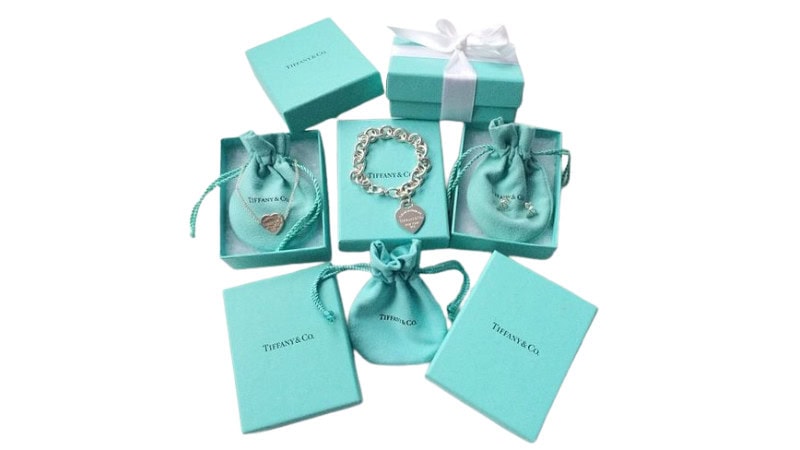
FAQs
Q1: Why is Tiffany’s packaging so famous?
Tiffany & Co. was the first jewelry company to use a bright blue box for its jewelry. In the 1990s, it trademarked the iconic blue color, preventing others from using it and making it exclusive to the brand.
Q2: What is the exact color of Tiffany Blue?
Tiffany Blue is Pantone 1837. It’s approximately equivalent to CMYK: 40,0,4,15 and RGB: #81D8D0. Pantone has never shared details on the color, so we can only approximate.
Q3: Can I use Tiffany Blue for my brand?
The “Tiffany Blue” name and color are trademarked by Tiffany & Co. for jewelry packaging and marketing. So, you can use the color, but you cannot call it “Tiffany Blue” or use it for any jewelry-related branding or packaging.
Q4: What makes Tiffany’s Packaging so Special?
Tiffany & Co. has a monopoly on the blue shade. The combination of high-quality packaging materials and exclusivity has made Tiffany’s packaging a standout among luxury brands.
Conclusion
Tiffany & Co.’s packaging is a perfect blend of color psychology, minimalism, and craftsmanship. The Tiffany Blue Box is more than just packaging; it’s a symbol of emotion, exclusivity, and timeless beauty. Every detail, from the soft white ribbon to the sturdy paperboard, tells a story of precision and purpose.
For brands aiming to create that same sense of prestige, Tiffany’s approach offers a clear lesson: luxury packaging isn’t about extravagance, it’s about consistency, quality, and emotional connection.
Design Your Brand’s Iconic Packaging with Packoi
With over 25 years of professional experience, Packoi specializes in crafting custom packaging solutions that reflect your brand’s unique identity. Our state-of-the-art design services, precise color matching, and eco-friendly material options allow you to design the perfect packaging for your needs.
With a wide variety of options, from elegant boxes and bags to durable gift packaging, Packoi is trusted by hundreds of businesses worldwide. We also provide discounts on bulk orders, making premium packaging accessible to brands of all sizes. To get a free quote, contact us now!


